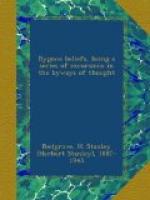“There is, therefore, a wonderful virtue and operation in every Herb and Stone, but greater in a Star, beyond which, even from the governing Intelligences everything receiveth and obtains many things for itself, especially from the Supreme Cause, with whom all things do mutually and exactly correspond, agreeing in an harmonious consent, as it were in hymns always praising the highest Maker of all things.... There is, therefore, no other cause of the necessity of effects than the connection of all things with the First Cause, and their correspondency with those Divine patterns and eternal Ideas whence every thing hath its determinate and particular place in the exemplary world, from whence it lives and receives its original being: And every virtue of herbs, stones, metals, animals, words and speeches, and all things that are of God, is placed there."[1] As compared with the ex nihilo creationism of orthodox theology, this theory is as light is to darkness. Of course, there is much in CORNELIUS AGRIPPA’S statement of it which is inacceptable to modern thought; but these are matters of form merely, and do not affect the doctrine fundamentally. For instance, as a nexus between spirit and matter AGRIPPA places the stars: modern thought prefers the ether. The theory of emanations may be, and was, as a matter of fact, made the justification of superstitious practices of the grossest absurdity, but on the other hand it may be made the basis of a lofty system of transcendental philosophy, as, for instance, that of EMANUEL SWEDENBORG, whose ontology resembles in some respects that of the Neo-Platonists. AGRIPPA uses the theory to explain all the marvels which his age accredited, marvels which we know had for the most part no existence outside of man’s imagination. I suggest, on the contrary, that the theory is really needed to explain the commonplace, since, in the last analysis, every bit of experience, every phenomenon, be it ever so ordinary—indeed the very fact of experience itself,—is most truly marvellous and magical, explicable only in terms of spirit. As ELIPHAS LEVI well says in one of his flashes of insight: “The supernatural is only the natural in an extraordinary grade, or it is the exalted natural; a miracle is a phenomenon which strikes the multitude because it is unexpected; the astonishing is that which astonishes; miracles are effects which surprise those who are ignorant of their causes, or assign them causes w hich are not in proportion to such effects."[1b] But I am anticipating the sequel.
[1] H. C. AGRIPPA: Occult Philosophy, bk. i., chap. xiii. (WHITEHEAD’S edition, pp. 67-68).
[1b] ELIPHAS LEVI: Transcendental Magic, its Doctrine and Ritual (trans. by A. E. WAITE, 1896), p. 192.




